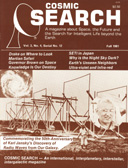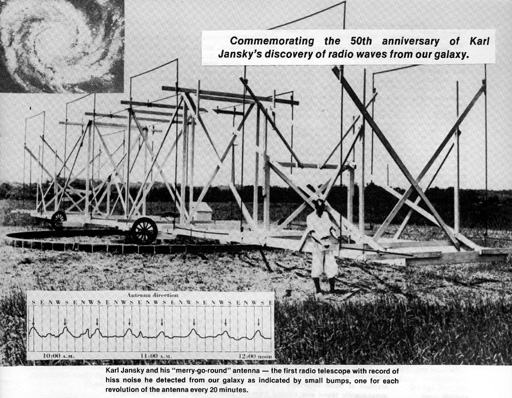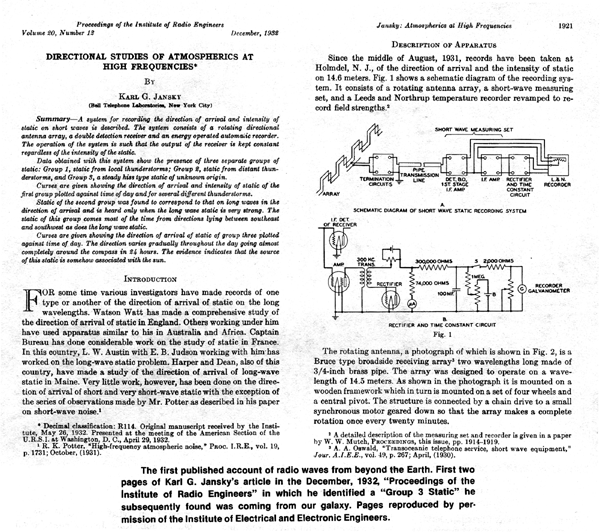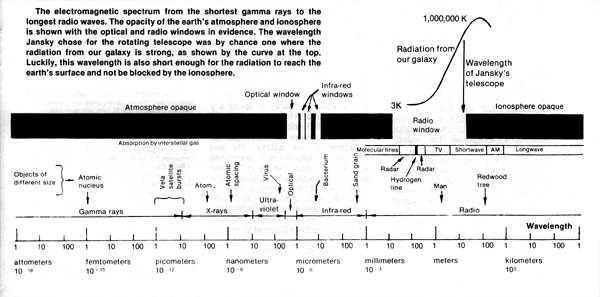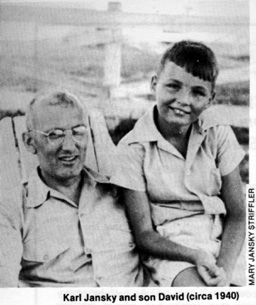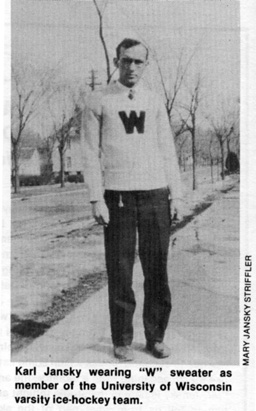![[NAAPO Logo]](../../Images/NAAPOsm.jpg) North American AstroPhysical Observatory (NAAPO)
|
|
The First 50 Years of Radio Astronomy,
Part 1: Karl Jansky and His Discovery of Radio Waves from Our Galaxy By: John Kraus
A universe of radio sounds to which mankind had been deaf since time immemorial now suddently burst forth in full chorus.
A bizarre contraption, reminiscent of the wing frame of an early Wright Brothers biplane, rotated slowly on the flat, open expanse of a fallow, southern New Jersey potato field. The metal tubes and wooden slats of the 30-meter "wing" rolled silently round and round a circular track on four rubber-tired wheels from a Model-T Ford.
The "wing" was a rotating directional antenna. Connected to a radio receiver in a small nearby shack, signals from the antenna were amplified and recorded by pen on a moving paper chart. On a warm autumn afternoon of 1931 a slender young radio engineer was puzzling over the long strip of paper flowing from the recorder.
An airplane "wing" rotating on automobile wheels in a potato field — what an improbable, unlikely combination! Yet it had been constructed for a very definite purpose. Karl Jansky, the young engineer, had built it to investigate the direction of arrival of the crackling thunderstorm noise or "static" which interfered with radio-telephone conversations over trans-Atlantic short-wave links of the Bell system.
Jansky found what he was looking for. Some static came from local thunderstorms, other static from more distant ones, the strength fluctuating greatly from hour to hour and day to day. But also, so weak that he might have ignored it, was a faint persistent static, always there, whose direction moved almost completely around the horizon once each day. Listening to the static with earphones, Jansky described it as a hissing sound "that can hardly be distinguished from the receiver noise." This hiss-like static Jansky had not expected or anticipated but it excited his curiosity and he determined to track it down.
He ruled out local interference from power lines or electrical equipment; he ruled out terrestrial sources. Could it come from the sun, he wondered. After further observations he concluded that the noise was coming from beyond the earth, beyond the sun and the solar system; it was coming in fact from the center of our galaxy or Milky Way system.
Jansky's airplane "wing" was the first radio telescope and with it he opened a new corridor to the cosmos! A universe of radio sounds to which mankind had been deaf since time immemorial now suddenly burst forth in full chorus. Humans could now turn, not only their eyes but also their radio ears to the heavens!
Jansky's discovery revolutionized astronomy and our ideas of the universe but in the 1930s astronomers and engineers hardly raised an eyebrow. It was a truly historic occasion when Jansky presented his final paper about his discovery on July 3, 1935, at the National Convention of the Institute of Radio Engineers in the Statler Hotel in Detroit, Michigan. However, scarcely two dozen people were in the audience. I was fortunate to be one of them.
Before describing Jansky's discovery and its consequences in more detail, let me provide a bit of historical perspective.
In ancient Greece hundreds of years before Christ, Hipparchus charted the stars. Later, Tycho Brahe of Denmark and Johannes Kepler of Germany studied the planets. Based on their work, Isaac Newton, a Cambridge University professor, enunciated his laws of motion in 1687. Meanwhile Galileo had built the first astronomical telescope and subsequently William Herschel built much larger ones leading to the modern era of observational astronomy. Newton's prism led to spectra of the stars and knowledge about their chemistry. Coming to the 20th century, Harlow Shapley measured the extent of our galaxy while Edwin Hubble noted the apparent recession of other galaxies suggesting that we live in an expanding universe. Much had been learned and, yes, there were questions to be answered but the sky seemed like a stable, well-ordered place where changes took place slowly, if at all. This was our picture of the firmament 50 years ago when Karl Jansky's merry-go-round telescope started turning.
Let us follow another path from the past to Jansky's telescope. Six centuries before Christ the ancient Greek astronomer-philosopher Thales knew that amber rubbed with a cloth became electrically charged. This phenomenon gives us our word "electricity" from the Greek word "elektron" for amber. Ancient sailors are reported to have used loadstone or magnetic compasses for navigation so electric and magnetic effects were known long ago. But electricity and magnetism were regarded as separate, unrelated phenomena and light as something still different.
Then in 1819, Hans Christian Oersted of Denmark discovered that a compass needle could be deflected by a wire carrying an electric current; electricity produced magnetism. A few years later, Michael Faraday in London demonstrated that a change in magnetism, produced by plunging a bar magnet into a coil of wire, induced an electric current; magnetism produced electricity.
The foundations had been laid and in 1873, Cambridge University professor, James Clerk Maxwell, propounded his laws relating electricity and magnetism. He postulated that light was an electromagnetic wave and further that electromagnetic waves of other lengths should be possible. Soon Heinrich Hertz, a professor at Karlsruhe, Germany, produced and measured electromagnetic waves a million times longer than light. These radiations, we now call radio waves, were put to practical use by Guglielmo Marconi, particularly for ship-to-shore telegraphy. By 1920 radio broadcasting had begun and radio waves were finding many other important applications. One of these was trans-oceanic telephone service using the then relatively short wavelengths of a few tens of meters. This was the setting in 1930 when Karl Jansky began his experiment that was destined to revolutionize our knowledge of the universe. From light waves confined to a "window" about one octave wide, Jansky opened a broader radio "window" dozens of octaves wide. Soon this radio window would reveal a violent, dynamic universe barely hinted at by earlier visual observations.
I have sketched briefly the history of optical astronomy and the events leading to the status of radio in 1930 when the sky belonged entirely to the realm of optical astronomy. Essentially all that we knew about the heavens had come from what we could see or photograph. Karl Jansky changed all that.
Karl Guthe Jansky was born in 1905 in what was then the Territory of Oklahoma where his father was Dean of the College of Engineering at the University of Oklahoma. Dean Jansky had been born in Wisconsin of Czech immigrant parents who came to the U.S. in 1867. Karl's mother, nee Nellie Moreau, was of French-English descent. In 1908 the family moved to Madison where father Jansky became a member of the Electrical Engineering faculty at the University of Wisconsin. Karl attended the university, obtaining a Bachelor of Science in physics in 1927. Because of his high scholarship, he was elected a member of Phi Beta Kappa. He also excelled athletically as the fastest man on the university's ice-hockey team.
In 1928, Karl Jansky joined the staff of the Bell Telephone Laboratories, assigned to the study of static and other radio interference. Some of his work was done at the long wavelength of 4000 meters. In March 1929, while still working on the long wavelength static, he began to design a system for observing static at about 15 meters, a wavelength coming into use for trans-Atlantic telephone service. His design included a rotating directional antenna, receiver and recording arrangement. Construction of the antenna began in the fall of 1929 and a year later the antenna and associated receiver-recorder were installed at an observing site near Holmdel, New Jersey. In the late summer of 1931 Karl Jansky started his antenna turning and his recorder running on a continuous basis and by that winter the mysterious hiss-like static was definitely recognized.
For some weeks the hiss-like static seemed to be strongest when the directional antenna was pointed toward the sun. However, over a period of some months the maximum moved away from the sun, following a fixed point among the stars which Jansky placed close to the center of our galaxy.
Our galaxy is an aggregation of some 100 billion stars turning slowly like a great wheel in space. Although the center of our galaxy is obscured from optical observation by intervening gas and dust it is a strong source of radio-wave emission.
In retrospect it in interesting to note that the system Karl Jansky designed for studying 15-meter wavelength static had:
All of these four characteristics are essential to modern radio telescopes. I believe that Jansky was the first person to combine these all together and in so doing he built the first successful radio telescope!
Others before Jansky had tried without success. In 1895 Oliver Lodge wondered if Heinrich Hertz's newly discovered waves might not be emitted by the sun. He set up a simple receiving system in Liverpool, England, but detected nothing except static and disturbances he attributed to passing street cars and nearby electrical equipment. Lodge concluded correctly that if such waves did exist his equipment was not sensitive enough to detect them. He further recommended that subsequent experiments be conducted "in some isolated country place" to avoid man-made interference. Lodge was a man ahead of his time.
Thomas Alva Edison also tried unsuccessfully to receive radio waves from the sun, while Nikola Tesla set up transmitting and receiving equipment near Pikes Peak, Colorado, in an unsuccessful attempt to "talk to the planets." All of these experiments were at long radio wavelengths. In contrast, Arthur Adel and I tried to detect radio waves from the sun in 1933 at short centimeter wavelengths with ammonia-line microwave equipment at the University of Michigan. Adel, now an astronomer at Northern Arizona University, theorized correctly that such radiation might be associated with activity near sun spots on the solar disc. However, our equipment, like Lodge's, was much too insensitive and we obtained no indication of the radiation.
By 1935 Jansky had demonstrated that the hiss-like radiations were received any time his antenna was directed towards some part of our galaxy, revealing its structure in a rudimentary way. The greatest response was obtained when the antenna pointed toward the center of our galaxy. This fact led Jansky to the conclusion that the source of the radiations was located in the stars themselves or in the interstellar matter distributed throughout the galaxy. Jansky noted that, if stars were the source, strong radiation should be observed from the sun, whereas at no time had he detected any solar radio radiation. His conclusion that stars are not an important source of the galactic radiation is correct. However, it so happened that Jansky had made his observations during a sunspot minimum. Had he continued his observations a few years more, he would undoubtedly have detected solar radiation during a period of high sunspot activity. Unfortunately, Jansky was soon transferred to other research activities, and years were to pass before further advances were made in the still unrecognized new science of radio astronomy.
Jansky suggested that the hiss-like static "might be caused by the thermal agitation of charged particles which are found in the very considerable amount of interstellar matter that is distributed throughout the Milky Way." Jansky's suggestion turns out to be correct if the words "thermal agitation" are interpreted to include electrons moving at high velocity in a magnetic field.
Jansky was well aware not only of the astronomical importance of his discovery but also of its practical implications. For example, he wrote in 1935 that "this star static, as I have always contended, puts a definite limit upon the signal strength that can be received from a given direction at a given time and when a receiver is good enough to receive that minimum signal it is a waste of money to spend any more on improving the receiver." Thus, by 1935 Jansky had identified the origin of the radio radiation with the structure of our galaxy. He had detected the radiation at 15 meters and also at 10 meters and he understood how this background radiation set a limit to useful receiver sensitivity. He realized that progress in radio astronomy would require larger antennas with sharper beams which could be pointed easily in different directions. In fact, he proposed the construction of a parabolic-mirror antenna 30 meters in diameter for use at meter wavelengths. However, he obtained no support for his proposal, and radio astronomy languished.
Karl Jansky died in 1950 at the age of 44. He had contracted Bright's disease, or nephritis at an early age resulting in a chronic kidney condition from which he never fully recovered. Although Grote Reber and a few others made advances in radio astronomy prior to 1950 there was yet nothing at the time to hint of the great leaps that would soon follow. Regrettably Karl Jansky did not live to witness the tremendous astronomical revolution that resulted from his discovery. However, his name
is commemorated in the radio astronomy unit, the jansky, for flux density or strength of radiation, putting him in the illustrious company of other electrical pioneers for whom the watt, ampere, volt, ohm, coulomb, hertz and farad are named.
References
1. "Directional Studies of Atmospherics at High Frequencies," Karl G. Jansky, Proceedings Institute of Radio Engineers, vol. 20, Dec. 1932, page 1920.
2. "Electric Disturbances Apparently of Extraterrestrial Origin", Karl G. Jansky, Proceedings
Institute of Radio Engineers, vol. 21, Oct. 1933, page 1387.
3. "A Note on the Source of Interstellar Interference," Karl G. Jansky, Proceedings Institute
of Radio Engineers, vol. 23, Oct. 1935, page 1158.
4. "My Brother Karl Jansky and His Discovery of Radio Waves from Beyond the Earth", C. M. Jansky,
Jr., Cosmic Search, vol. 1, Fall 1979, page 12.
5. "Radio Astronomy," John Kraus, McGraw-Hill Book Co., New York, 1966, pages 6 and 328.
6. "Big Ear," John Kraus, Cygnus-Quasar Books, Powell, Ohio 1976, page 21.
7. "The Changing Universe," John Pfeiffer, Random House, New York, 1956.
|
